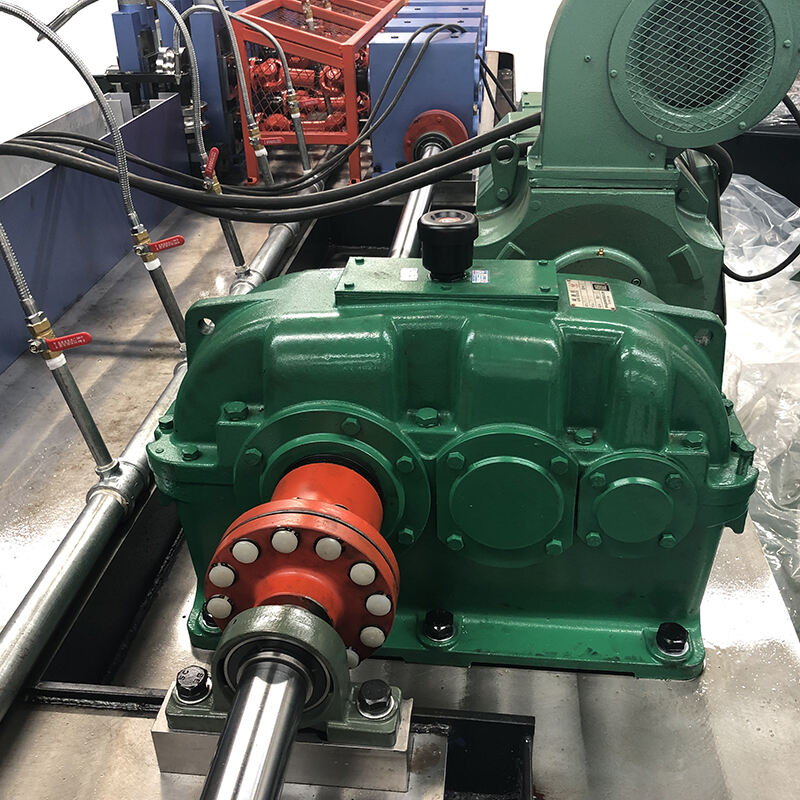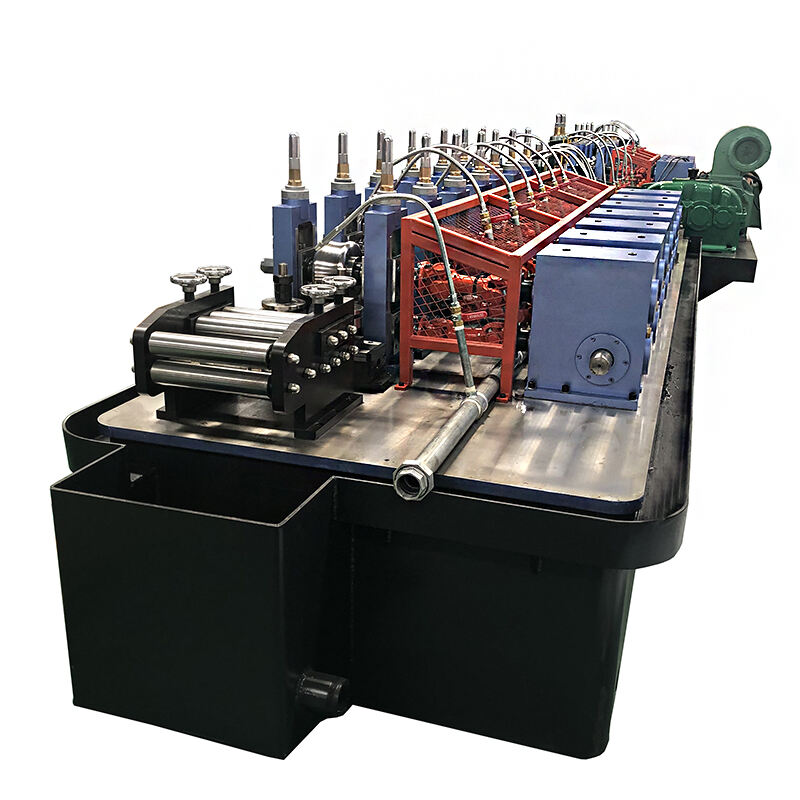Comprendiendo la Tecnología Moderna de Molino de Tubos ERW
La Soldadura por Resistencia Eléctrica (ERW) se ha convertido en un pilar fundamental de la fabricación industrial moderna, representando una sofisticada combinación de ingeniería de precisión y capacidades de producción automatizadas. Estos sistemas avanzados transforman tiras planas de acero en tubos soldados de alta calidad mediante un proceso cuidadosamente coordinado de conformado, soldadura y acabado. La tecnología detrás de los molinos de tubos ERW ha evolucionado significativamente, ofreciendo a los fabricantes niveles sin precedentes de control, eficiencia y consistencia del producto.
Las operaciones actuales en plantas de tubos ERW incorporan características de última generación que permiten producir tubos con una precisión dimensional excepcional y una calidad de soldadura superior. Desde componentes automotrices hasta soportes estructurales, las aplicaciones de tubos fabricados mediante ERW abarcan numerosas industrias, lo que hace que las capacidades de estas plantas sean cada vez más vitales para la fabricación moderna.
Componentes Principales y Características Operativas
Diseño Avanzado de la Sección de Formación
La sección de formación de una Molino de tubos de agua representa la fase inicial y crucial del proceso de producción de tubos. Las plantas modernas cuentan con bastidores de formación precisamente diseñados que van moldeando gradualmente la banda de acero en un perfil circular. Estos bastidores utilizan diseños sofisticados de rodillos que minimizan el esfuerzo del material y garantizan una formación uniforme en distintos tamaños de tubo. La tecnología más reciente incorpora sistemas de ajuste controlados por computadora que permiten cambios rápidos de tamaño y un posicionamiento óptimo de los rodillos.
Sensores avanzados y sistemas de monitorización siguen continuamente el proceso de conformación, realizando ajustes en tiempo real para mantener un control dimensional preciso. Este nivel de automatización garantiza una calidad consistente, al mismo tiempo que reduce el tiempo de configuración y el desperdicio de material, haciendo que la máquina de tubos de soldadura por resistencia eléctrica (ERW) sea más eficiente y rentable.
Integración del Sistema de Soldadura
El núcleo de una máquina de tubos ERW radica en sus capacidades de soldadura. Los sistemas modernos utilizan tecnología de soldadura de alta frecuencia que ofrece un control preciso del calor y una excelente integridad de la soldadura. La sección de soldadura cuenta con fuentes de alimentación avanzadas que mantienen una entrega constante de energía, asegurando una calidad uniforme de la soldadura durante toda la producción. Sistemas de refrigeración sofisticados controlan la temperatura durante el proceso de soldadura, evitando la deformación del material y manteniendo la estabilidad dimensional.
Los sistemas de control de calidad integrados en la sección de soldadura utilizan métodos avanzados de prueba, incluyendo inspección ultrasónica y prueba de corrientes parasitarias, para verificar la integridad de las soldaduras en tiempo real. Esta capacidad de monitoreo continuo permite a los fabricantes identificar y abordar posibles problemas antes de que afecten la calidad del producto.

Versatilidad en la Producción y Manipulación de Materiales
Capacidades de Rango de Tamaño
Las modernas laminadoras de tubos ERW demuestran una versatilidad notable en sus capacidades de producción. Estos sistemas generalmente pueden manejar una amplia gama de tamaños de tubos, desde tubos de precisión de pequeño diámetro hasta productos estructurales más grandes. La capacidad de cambiar rápidamente entre diferentes especificaciones de tamaño hace que estas laminadoras sean altamente adaptables a requisitos de producción variables. Sistemas avanzados de cambio rápido y características de configuración automatizadas minimizan el tiempo de inactividad durante los cambios de producto.
La precisión de los modernos laminadores de tubos ERW se extiende al control del espesor de la pared, lo que permite a los fabricantes producir tubos con especificaciones exactas para satisfacer las diversas exigencias de la industria. Esta versatilidad convierte al laminador de tubos ERW en un activo invaluable para fabricantes que atienden múltiples segmentos del mercado.
Mejora en el Procesamiento de Materiales
Los laminadores de tubos ERW actuales incorporan sofisticados sistemas de manejo de materiales que garantizan un flujo de producción suave y eficiente. Los sistemas avanzados de entrada cuentan con guía precisa de la tira y control de tensión, manteniendo alineado de forma óptima el material durante todo el proceso de formación. Los sistemas automatizados de seguimiento del material monitorean el consumo de la tira y predicen necesidades de mantenimiento, ayudando a optimizar la planificación de la producción y reducir tiempos de inactividad inesperados.
La integración de capacidades avanzadas en el procesamiento de materiales permite que estos laminadores manejen diversos grados de acero y acabados superficiales, expandiendo su potencial de aplicación. Los laminadores modernos suelen incluir opciones de tratamiento en línea, como dimensionamiento, corte y acabado de extremos, ofreciendo soluciones completas de producción.
Control de Calidad y Gestión de Producción
Sistemas de Monitoreo Avanzados
El control de calidad en los laminadores modernos de tubos ERW depende de sistemas sofisticados de monitoreo e inspección. Cámaras de alta resolución y dispositivos láser de medición siguen continuamente la precisión dimensional y la calidad superficial. Estos sistemas proporcionan retroalimentación en tiempo real a los operadores y ajustan automáticamente los parámetros de producción para mantener una calidad óptima del producto.
Las capacidades de recopilación y análisis de datos permiten a los fabricantes seguir tendencias de producción, identificar posibles problemas antes de que se conviertan en errores y mantener registros completos de calidad. Este nivel de monitoreo garantiza una calidad de producto consistente, a la vez que proporciona información valiosa para la mejora de procesos.
Características de Eficiencia en la Producción
Las modernas laminadoras de tubos ERW incorporan numerosas características diseñadas para maximizar la eficiencia de producción. Los sistemas de control automático de velocidad optimizan el funcionamiento de la laminadora en función de las propiedades del material y las especificaciones del producto. La programación inteligente de mantenimiento ayuda a prevenir tiempos de inactividad inesperados, asegurando al mismo tiempo un rendimiento óptimo del equipo. Los sistemas de gestión energética monitorean y optimizan el consumo de electricidad, reduciendo los costos operativos sin comprometer la calidad de producción.
La integración de tecnologías de la Industria 4.0 permite capacidades de monitoreo y control remoto, lo que posibilita a los fabricantes gestionar la producción de manera más eficaz y responder rápidamente a requisitos cambiantes. Estas características avanzadas contribuyen a una mayor productividad y a la reducción de costos operativos.
Preguntas Frecuentes
¿Qué ventajas ofrece una planta de tubos ERW frente a otros métodos de producción de tubos?
Las plantas de tubos ERW ofrecen varias ventajas distintas, incluyendo mayores velocidades de producción, mejor precisión dimensional y una calidad de soldadura más consistente. También proporcionan mayor flexibilidad en términos del rango de tamaños y opciones de materiales, mientras que generalmente requieren menos energía y generan menos residuos en comparación con otros métodos de producción.
¿Cómo asegura el sistema de control de calidad en una planta de tubos ERW la consistencia del producto?
Las modernas laminadoras de tubos ERW emplean múltiples capas de control de calidad, incluyendo monitoreo en tiempo real de la soldadura, inspección dimensional y verificación de la calidad superficial. Sensores avanzados y equipos de prueba monitorean continuamente los parámetros de producción, mientras que sistemas automatizados realizan ajustes inmediatos para mantener las especificaciones del producto.
¿Cuáles son los requisitos de mantenimiento típicos para una laminadora de tubos ERW?
Las laminadoras de tubos ERW requieren mantenimiento regular de los rodillos de conformación, componentes de soldadura y herramientas de corte. Los sistemas modernos incluyen características de mantenimiento predictivo que monitorean el estado del equipo y alertan a los operadores sobre posibles problemas antes de que causen interrupciones en la producción. La calibración regular de los sistemas de medición y equipos de inspección también es esencial para mantener la calidad del producto.

